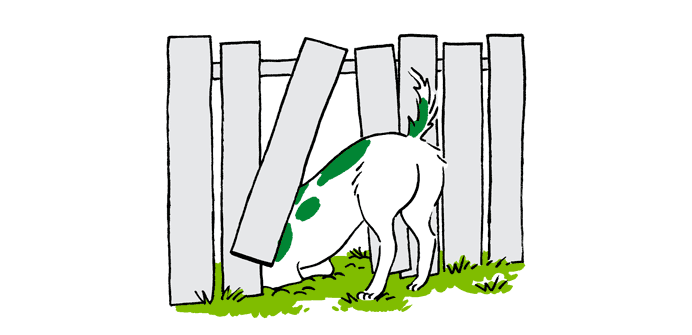
Could Your Dog Escape Your Yard? Here’s How to Secure It
For some dogs, a simple fence isn’t enough to keep them in the yard. Maybe you’ve got a little escape artist that’s too smart for their own good. Maybe you’re raising a brave explorer who loves to get lost. Or maybe you’ve been unlucky enough to have your dog stolen from their own backyard. Creating a safe and secure space to keep your pet can be a challenge, but we’re here to help. Understanding the common reasons dogs get out and what you can do to prevent it from happening goes a long way toward keeping your furry friend safe.
Why Does Your Dog Want to Escape?
Securing your yard starts with understanding the impulses that drive your dog to see what’s beyond your property. Spaying or neutering is an important first step in curbing a dog’s desire to roam, but there may be other factors at play. Creating a safe yard for a lonely Labrador in search of a friend is an entirely different exercise than securing a burrow-happy beagle on the hunt for a squirrel. We’d recommend trying to learn as much as you can about your dog’s breed and underlying instincts. The most common reasons dogs try to escape are:
- Feeling socially isolated
- Lack of stimulation (think toys)
- Desire to escape something that scares them, like thunder
Countering these behaviors starts with understanding which one is at the heart of your dog’s desire to break free. Once you’ve got a theory of what’s motivating your pup, it’s time to give your safety measures a second look.
How to Keep Your Dog Safe and Secure in Your Yard
Microchip Your Dog and Scan Their Nose
If your dog is committed to getting out, your most useful tool will be the ability to track and locate them wherever they’re found. There are a huge variety of products and services designed to help you keep your dog safe, but the most important thing you can have is a plan. You’ve most likely heard of GPS tracking chips that can be implanted in your pet, but you may not know that you can also scan their nose. Through a new app called NOSEiD, you can capture your dog’s unique nose print, which will give whoever finds them a faster, simpler way of reuniting the two of you. It’s that easy! Just download the app, call your pup over and start scanning.
The Best Defense Is a Good … Fence
Even though they’re not technologically impressive, a sturdy wooden or metal fence still plays an important part in protecting your dog while they’re in your yard. Not only does it keep your dog from wandering, it also keeps unwanted animals and people away from your dog’s space. If your dog can leap over it, you’ll obviously need to raise the height, or you can add an overhang that makes it harder to clear. You might also consider planting some shrubs along the inside of the fence to discourage jumping. If your dog is burrowing beneath your fence, consider adding a barrier beneath it or putting a bumper collar on them, which makes it harder to squeeze into small spaces.
If you have a particularly territorial dog, you may want to cover any open spots in your fence that your dog might spy adversaries through. A solid fence may help them feel safe and diminish their need to patrol their surroundings.
Make “Yard” Mean “Yay!”
Making your yard a dog-friendly and entertaining space is a huge part of keeping your dog safe at home. With enough toys, space to burn energy and ideally a friend to play with, your dog won’t have any reason to see if the grass is greener elsewhere. A few popular dog-pleasers you may want to provide are:
- A bit of shelter or shade
- A source of water
- A rotating lineup of toys
- Their favorite playmate (you)
Use Your Yard Wisely
Last, but not least, if you leave your dog unattended for a long period of time in your yard, there’s a good chance they will get bored and look for a way to burn off some energy. To prevent them from getting mischievous, limit the amount of time they’re out on their own, and check in frequently. Also, for dogs with separation anxiety or that may be afraid of loud noises, your presence will help keep them calm and close to home.
With your dog chipped or their nose scanned, you’ll always have an option in the event that your dog strikes out on their own. Beyond that, understand what makes your dog unique and check your yard’s safety features regularly for holes or weak points. As usual, a little preparation now can save you a ton of time and energy in the long run.




